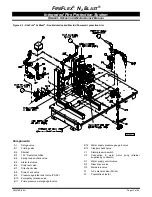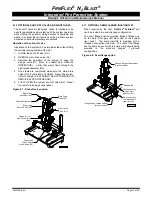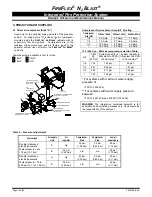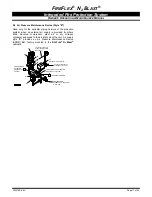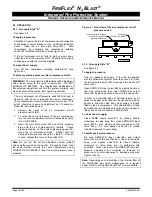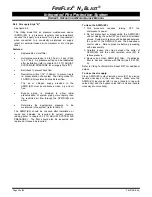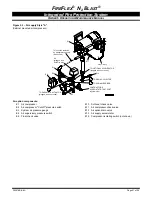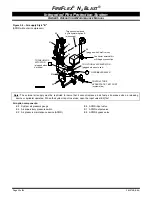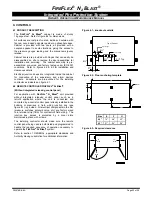
F
IRE
F
LEX
®
N
2
B
LAST
®
Integrated Fire Protection System
O
WNER
'
S
O
PERATION
&
M
AINTENANCE
M
ANUAL
Page 10 of25
FM-076B-0-6A
4.8.3 Main drain test
A main drain test shall be conducted to determine
whether there has been a change in the condition of the
water supply piping and control valves (as per NFPA25).
1. Record the water supply pressure indicated by the
pressure gauge
(B12)
.
2. FULLY OPEN the drain test valve
(B6)
.
3. Record residual water supply pressure indicated by
the pressure gauge
(B12)
.
4. SLOWLY CLOSE the drain test valve
(B6)
.
5. Record the water supply pressure indicated by the
pressure gauge
(B12)
.
6. Readings shall be compared with those made at the
time of the original acceptance tests or with those
made at the time of the last test to determine whether
there has been any deterioration of the water supply.
Note:
A main drain test shall be conducted any time the
water supply control valve (
D1
) is closed and reopened at
the system.
4.8.4 Monthly inspection
1. Gauges on preaction system shall be inspected to
ensure that normal air and water pressures are being
maintained.
2. Verify that the control valves are in the following
condition:
In the normal open or closed position.
Properly
supervised.
Accessible.
Free from external leaks.
3. The deluge valve (
A1
) and associated components
shall be externally inspected to verify the following:
The valve is free from physical damage.
All trim valves are in the appropriate open or
closed position.
The valve seat is not leaking.
Electrical components are in service.
4. Check
alarm
device
(C1)
switch by opening the alarm
test valve
(B5)
.
5. Conduct low air pressure supervisory test (refer to
chapter 4.8.1).
6. Refer any noted problems or deficiencies to
authorized service personnel for correction.
4.8.5 Semi-annual inspection
1. Check main water supply control valve
(D1)
switch
upon movement of the hand wheel.
2. Check
alarm
device
(C1)
switch by opening the alarm
test valve
(B5)
.
3. Check the sprinklers piping for corrosion and
damage.
4. Check all piping supports to insure they are tight and
properly secured.
5. Perform functional test of all components of the
system.
WARNING
Prior to any functional tests, the actuator
(C)
must be removed to prevent cylinder
(A)
discharge.
4.8.6 Annual inspection
1. Perform semi-annual inspection.
2. Check all detectors at the remote releasing control
panel.
3. Check all releasing conditions.
4. Check all audible & visual devices at the remote
releasing control panel.
5. Perform sequence of operation (refer to chapter 4.4).
6. Perform manual emergency release test of the
preaction system.
7. Perform full trip test.
8. Perform drain test.
4.8.7 Long term inspection
1. Alarm valves and their associated strainers, filters,
and restriction orifices shall be inspected internally
every 5
years unless tests indicate a greater
frequency is necessary.
2. Riser
check
(D2)
shall be inspected internally every
5 years unless tests indicate a greater frequency is
necessary.
3. Test on gauge (gauge precision required: less than
3% of the full scale).
4.9 MAINTENANCE
The system shall be maintained in full operation condition
at all times.
All troubles or impairments shall be corrected promptly
consistent with the hazard being protected.
The
N
2
Blast
®
FPS
-
250 and FPS-750 utilize three
different filters, seen in the figure to the right. The filters
must be changed out annually or every 1000 hours (hour
meter located on the outside bottom right corner of the
cabinet) of operating time, whichever comes first.
(please refer to South-Tek manual for details)

















